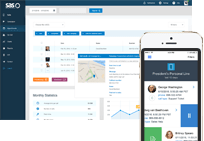- Log In
- Support
- Company
- Contact Us
- Live answers @ 1-888-532-4794
Small Business Pricing to Win, Part 4: 6 Mistakes to Avoid

Welcome to part 4 of our Small Business Pricing to Win series. In Parts 1, 2 and 3, we explored pricing strategies, factors that influence price, and how to decide on the right price for your particular offering. In this last entry, Part 4, we will show you the 6 most common mistakes that small business owners make when determining the right price for their product or service and how to avoid them.
- Being the lowest price in the market
While “low price equals high volume” is a fundamental economic theory, it is primarily applicable for non-differentiated commodities. In laymen’s terms, that means your offering can’t be differentiated from competitors’. In that scenario, you basically wouldn’t be in business. But if you are in business, then hear this: pricing low often creates multiple problems – it leads to a poor perception of quality in the customer’s mind, incites price wars with the competition, and sets the bar super low in terms of the value that you should be providing. So, unless you are a giant like Walmart, pricing low is best avoided. Instead, look for ways to add value to your offerings, and command premium prices.
- Pricing high and not selling right
Though pricing low can be harmful, pricing high and not being able to communicate value to your customers is disastrous. If you are unable to demonstrate why your products and services warrant a fat price tag, customers will leave you and never come back.
- Forgetting the message that price communicates
When small businesses price their offerings, they usually take into consideration the costs involved, their anticipated profits, and how the competition is pricing. But one thing that is often forgotten is the fact that pricing is a strong positioning tool. Ever heard of the psychology of pricing? When you price your product high, you are communicating a first-class image to the consumer. Thus, other elements of your brand should also communicate a consistent message:
- You need to have expensive packaging, and use premium channels to sell the product. Would a Tiffany’s ring have the same appeal in a plastic box at a kiosk? Um, no.
- You should have trained customer service professionals handling sales and service inquiries around the clock. If you stink at customer care, then patrons may hightail it to competitors just to avoid the hassle.
These elements will help you command a good market share even when your prices are high. After all, not all customers are price-sensitive, and price-sensitive customers are generally willing to pay for value.
- Not considering all costs
Small businesses may neglect to add up all of their expenses before pricing their products. This is especially true for traders who buy in bulk. If you buy a product for $2 and sell for $5, you have a gross margin of $3. However, if you didn’t account for costs (e.g. rent, payroll, insurance, etc.) when you decided on pricing, then your net margin may be negative. This blunder will quickly run your business into the ground. Go back to Part 3 and make a running list of your expenditures (download an expenditures worksheet here).
- Wrong timing and payment models
Research has shown that people are more likely to use a product when they have recently paid for it as opposed to when it was paid for in the distant past. A typical example is a gym membership. A member who pays on a monthly basis is more likely to use the gym regularly, whereas someone who paid at the beginning of the year may ditch the elliptical machine for a bag of Cheetos and a Game of Thrones marathon. Small businesses, in an eagerness to make the sale and get more cash up front, try to sign customers up long-term. But those people are least likely to renew their purchase. In short, charge your customers using a monthly subscription fee. That way, the value received is proportional to the price paid.
- Wrong discounting strategy
Discounting is a very powerful pricing tool, but it is a double-edged sword, and small businesses often go wrong with their discounting strategy. If you have a bunch of regular customers, suddenly offering a discount to newcomers may cause dissatisfaction in the minds of people who purchased earlier. No one wants to miss out on a good deal. Therefore, instead of offering discounts for all purchases, tie it up with loyalty, or offer discounts for a differentiated offering. For example, you could offer a 10% discount for customers who purchase a second time in your store. Or you could bundle 2 products, and offer a combination deal.
Ultimately, maximizing your profits comes down to pricing things just right based on your particular situation – and you probably won’t perfect it on the first try. Heck, if pricing were easy, we wouldn’t have needed 4 separate blogs to explain it! That being said, the greatest challenge for the small business owner is identifying why customers should shell out their hard-earned bucks for your products or services and convincing them it’ll be worth their while. Developing the ultimate pricing strategy takes time.
Categories
- Advice (32)
- Answering Service 101 (18)
- Best Practices (10)
- Call Center Jobs (6)
- Call Center Software (20)
- Comparison (2)
- Customer Service (30)
- Funny (31)
- Holidays (19)
- Industry Hacks (19)
- Infographics (53)
- International (1)
- Medical (8)
- News (12)
- Phone Etiquette (2)
- Phones (14)
- Pricing (8)
- Quizzes (3)
- Receptionist (11)
- SAS Products (29)
- Scripting (4)
- Services (5)
- Small Business (25)
- Starting Up (7)
- Tips and Tricks (19)
- Uncategorized (1)
- Videos (19)
- Workplace (6)
Recently writen
- Call Center Script Best Practices: Advanced Script Block Tips to Optimize Your Answering Service
- January 2025 Release Notes – Adjustments to Call Details Timeline, New Scripting Updates, Live Transcription, and more!
- April 2024 Release Notes – Voicemail Greetings, Ability to Access Websites With a Username and Password, and more!
- March 2024 Release Notes – New Add-On, Settings Revamp, and more!
Follow Us
How about a demo?
We'll show you how our web portal works and answer any questions you have about SAS.
Schedule a demo







